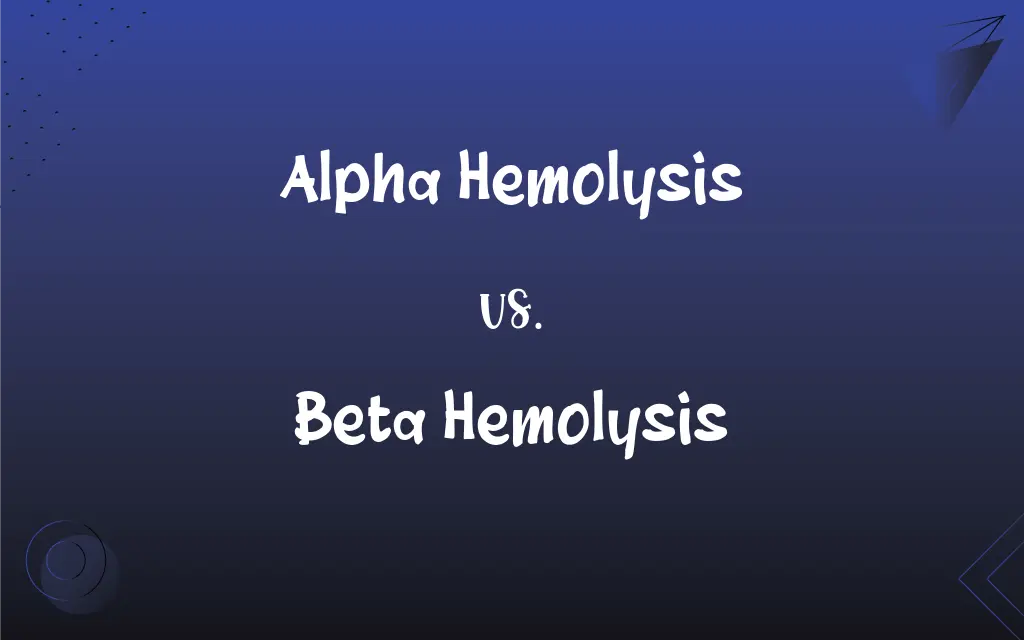Alpha Hemolysis vs. Beta Hemolysis: What's the Difference?
Edited by Janet White || By Harlon Moss || Updated on October 27, 2023
Alpha hemolysis causes a greenish discoloration on blood agar due to partial hemolysis, while beta hemolysis results in a clear zone due to complete lysis of red blood cells.

Key Differences
In the microbiological world, alpha hemolysis and beta hemolysis refer to the hemolytic reactions displayed by certain bacteria on blood agar plates. Alpha hemolysis, also known as partial hemolysis, doesn't fully break down the red blood cells. Instead, it results in a greenish discoloration of the agar around bacterial colonies. Conversely, beta hemolysis indicates complete hemolysis, where red blood cells are entirely lysed, producing a clear, transparent zone around bacterial colonies.
Observing alpha hemolysis on a blood agar plate provides valuable clues about the type of bacteria present. The greenish hue, often associated with alpha hemolysis, arises due to the partial reduction of the hemoglobin in red blood cells. In contrast, the presence of beta hemolysis can be a sign of more virulent bacterial strains, as they can entirely lyse and thus destroy the red blood cells surrounding them on the agar.
While both alpha hemolysis and beta hemolysis are critical diagnostic tools, they each hint at different bacterial species. For instance, Streptococcus pneumoniae often displays alpha hemolysis, creating a greenish tint around its colonies. On the other hand, certain strains of Streptococcus pyogenes exhibit beta hemolysis, leading to a clear zone around bacterial growth due to the complete destruction of red blood cells.
It's worth noting that while alpha hemolysis signifies a reduction of hemoglobin, it doesn't imply the bacterial species is less harmful or virulent than those causing beta hemolysis. Both types of hemolytic reactions offer microbiologists a glimpse into the bacterial species' potential effects and their interactions with host red blood cells.
In summary, alpha hemolysis and beta hemolysis are two distinct hemolytic reactions demonstrated by bacteria on blood agar plates. While alpha hemolysis showcases a greenish discoloration due to the partial breakdown of red blood cells, beta hemolysis reveals a clear zone, indicating the complete lysis of these cells.
ADVERTISEMENT
Comparison Chart
Hemolysis Type
Partial hemolysis.
Complete hemolysis.
Appearance on Blood Agar
Greenish discoloration around colonies.
Clear, transparent zone around colonies.
Hemoglobin Reduction
Hemoglobin in red blood cells is partially reduced.
Hemoglobin in red blood cells is fully lysed.
Typical Bacterial Association
Often linked with Streptococcus pneumoniae.
Commonly associated with certain strains of Streptococcus pyogenes.
Implication
Does not fully break down red blood cells.
Completely lyses and destroys red blood cells.
ADVERTISEMENT
Alpha Hemolysis and Beta Hemolysis Definitions
Alpha Hemolysis
A greenish tint on blood agar due to hemoglobin reduction.
The lab identified the bacterium by its characteristic alpha hemolysis.
Beta Hemolysis
Hemolytic reaction indicating full destruction of red blood cells.
The transparent area around the bacterial colony is due to beta hemolysis.
Alpha Hemolysis
Hemolytic activity causing partial breakdown of red blood cells.
The bacterial strain, when cultured, demonstrated alpha hemolysis.
Beta Hemolysis
A clear zone on blood agar due to complete lysis of red blood cells.
Streptococcus pyogenes produced a noticeable beta hemolysis on the plate.
Alpha Hemolysis
A partial hemolytic reaction seen in some bacteria.
On the blood agar plate, Streptococcus pneumoniae exhibited alpha hemolysis with a greenish discoloration.
Beta Hemolysis
Diagnostic clear or transparent discoloration on blood agar.
Beta hemolysis provides clues about potential bacterial pathogens.
Alpha Hemolysis
Incomplete lysis of red blood cells around bacterial colonies.
The sample showed a distinct pattern of alpha hemolysis on the agar.
Beta Hemolysis
Total hemolysis exhibited by certain bacteria on blood agar.
In the lab, the presence of beta hemolysis often points to virulent bacterial strains.
Alpha Hemolysis
Diagnostic greenish hue on blood agar plates.
Alpha hemolysis is indicative of certain bacterial species.
Beta Hemolysis
Complete hemolytic activity seen in certain bacterial species.
The bacterium exhibited strong beta hemolysis, clearing the surrounding agar.
FAQs
Can a bacterium exhibit both types of hemolysis?
Typically, bacteria will display either alpha or beta hemolysis, not both.
Is beta hemolysis indicative of more virulent bacteria?
Yes, beta hemolysis can indicate more virulent bacterial strains.
Is beta hemolysis harmful to the host?
Beta hemolysis indicates the complete destruction of red blood cells, which can be harmful.
How does beta hemolysis differ from alpha hemolysis?
Beta hemolysis results in a clear zone on blood agar due to complete lysis of red blood cells.
Which bacteria are typically associated with alpha hemolysis?
Streptococcus pneumoniae often displays alpha hemolysis.
Why is hemolysis important in microbiology?
Hemolysis can help in identifying and differentiating bacterial species based on their hemolytic reactions.
What causes the greenish discoloration in alpha hemolysis?
The color results from the partial reduction of hemoglobin in red blood cells.
Are there any health implications of bacteria causing beta hemolysis?
Yes, bacteria causing beta hemolysis can be pathogenic and lead to diseases.
Can antibiotics affect the degree of hemolysis?
Some antibiotics can affect bacterial growth and, subsequently, their hemolytic patterns.
Is beta hemolysis always indicative of a bacterial infection?
While indicative of certain bacteria, beta hemolysis alone isn't a confirmed sign of an infection.
Why is the complete lysis of red blood cells significant?
Complete lysis, as in beta hemolysis, indicates the bacteria's capability to break down and potentially harm host tissues.
Are blood agar plates the only medium to observe hemolysis?
Blood agar is the primary medium for observing hemolysis, but other specialized media can also show hemolytic reactions.
What is alpha hemolysis?
Alpha hemolysis is a partial hemolytic reaction, causing a greenish discoloration on blood agar.
Is the greenish tint in alpha hemolysis due to complete breakdown of red cells?
No, the greenish tint in alpha hemolysis indicates partial hemolysis.
How is the degree of hemolysis determined?
The degree is visually assessed by the discoloration around bacterial colonies on blood agar.
Is alpha hemolysis exclusive to Streptococcus pneumoniae?
No, while it's common in Streptococcus pneumoniae, other bacteria can also exhibit alpha hemolysis.
Can other types of hemolysis occur on blood agar?
Yes, besides alpha and beta, there's also gamma hemolysis, indicating no hemolysis.
Can the degree of beta hemolysis vary among bacterial strains?
Yes, some strains might produce a more pronounced clear zone than others.
Can environmental factors influence hemolysis?
Yes, factors like temperature and oxygen levels can affect bacterial growth and their hemolytic patterns.
Can the presence of hemolysis affect treatment choices?
Yes, knowing the type of hemolysis can guide treatment choices, especially in bacterial infections.
About Author
Written by
Harlon MossHarlon is a seasoned quality moderator and accomplished content writer for Difference Wiki. An alumnus of the prestigious University of California, he earned his degree in Computer Science. Leveraging his academic background, Harlon brings a meticulous and informed perspective to his work, ensuring content accuracy and excellence.
Edited by
Janet WhiteJanet White has been an esteemed writer and blogger for Difference Wiki. Holding a Master's degree in Science and Medical Journalism from the prestigious Boston University, she has consistently demonstrated her expertise and passion for her field. When she's not immersed in her work, Janet relishes her time exercising, delving into a good book, and cherishing moments with friends and family.
































































